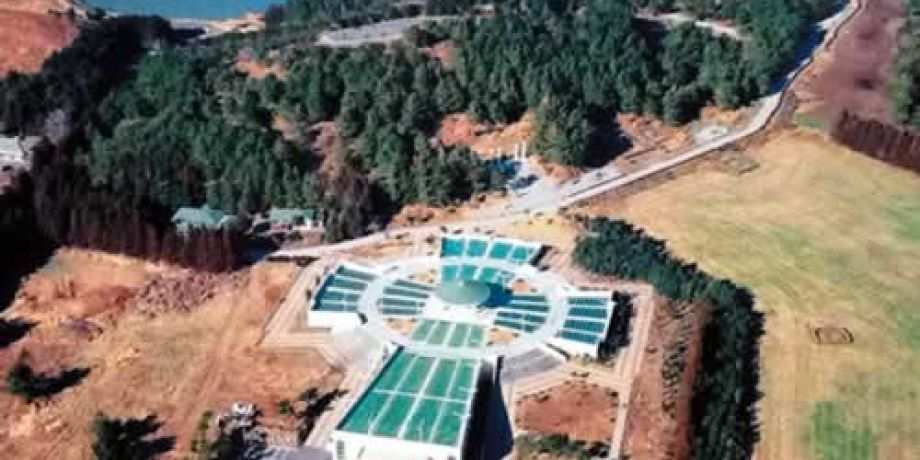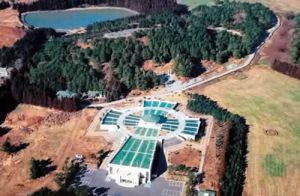
Hallim Parish
The Paris Foreign Mission Society handed over pastoral responsibility for Jeju Island to the Columban Fathers in 1933. At that time it had two small parishes, one in the north and one in the south of the island. The Japanese occupied Korea until 1945 when they were expelled at the end of World War II. During that time they made missionary work almost impossible. Then in 1950 the Korean War broke out, and two million people were killed, and the country was devastated with starvation prevalent everywhere. I was appointed to Korea in June 1952 and later, after some delays with visa clearance and language studies, I was appointed by the Columban Fathers to open a third parish on the western side of the island. The name of the new parish was Hallim. This was a township consisting of 26 scattered farm villages with a total population of 20,000 people, all living in small, thatched houses. Of course there was no priest’s house or church or other building. But more importantly, there were 25 baptized Catholics! I gathered them together in one of the Catholic houses for Mass in Latin! They had been well prepared by a group of St.Paul de Chartres Sisters who had come with thousands of other people to the island as refugees.

At that time each Columban Father was given the equivalent of $55.00 a month for living expenses, so there was no money for building of any kind. Then an extraordinary thing happened. One very dark, moonless night in April 1954 a 9,000 ton American freighter, on its way from Vietnam to Japan, had a radar breakdown and ran aground in the middle of the parish. It didn’t topple to one side but remained upright, stuck in the soft volcanic rock of the island. The bow of the ship was lifted high in the air and the stern was in deep water. It would require a number of oceangoing tugs to pull her back afloat. Some of the crew lowered a makeshift elevator from the bow, and I was able to go on board and meet the captain. There were several large holes torn on both sides of the hull, but thanks to the lessons learned from the Titanic disaster, the builders of this freighter had made sure that all of the cargo holds were independently sealed so that water leaking into the ship could not spread to other areas.
The captain asked me what I was doing on this remote island in the Yellow Sea. I explained that I was a Columban missionary priest, but that I was only recently arrived and had no priest’s house or church to which I could invite him and his crew. After some quiet thinking the captain said he had a surplus of lumber on board, and he would be happy to give me as much timber as I could unload in four days. Needless to say I regarded this man as a heaven-sent angel. I rushed back to the village with the good news.
Among our 25 Catholics we only had half a dozen who could do heavy work. Nevertheless, we decided to gather at the ship at dawn. But much to my surprise, a couple of hundred of able-bodied men turned out as volunteers! Our Catholics had spread the word to their neighbors, and for four days they worked from dawn to dark. We got enough timber to build a church and priest’s house and that is when I came to know something of the caliber of these islanders.
Jeju is famous for its abundance of rocks. Just as they did with the timber from the ship, hundreds of volunteers carried rocks on their backs to a piece of ground outside the village. This site had been procured many years before I arrived in Hallim. Next we needed sand and gravel. That was available in plenty from the sea shore a few miles away. To move it I approached the Korean army who agreed to lend me a couple of trucks for a week provided I fed the drivers and supplied the gasoline. I approached another military base (Marines), and they gave me the gasoline.
I still needed cash to pay for cement and for one professional carpenter and one stone mason. All the other labor was supplied by our volunteers. Here again the good Lord intervened!
All Columbans must make an annual retreat. This meant going to Seoul which was a time-consuming and tiresome journey involving ten hours by small wooden boat to the mainland and a further ten hours by train to Seoul.
By an extraordinary turn of events I found myself getting a free ride to Seoul on an American bomber which had to stop off for two hours at a large American Air Force base half way to Seoul. There I had the amazing good fortune to meet the Catholic chaplain, Fr. George Gerner. Like the ship captain, he wanted to know what I was doing in Jeju Island. So I told him, and he agreed to send me the Sunday collection every week thereafter. And that is how we built the Hallim parish church. The parish numbers increased so much that over the years four new parishes were formed out of the original one.
The second church, shaped like a Celtic cross, is part of a shrine called the Hill of Grace. It has a life-size Stations of the Cross and a Rosary Walk around a small lake. It also has a retreat house to which about 8,000 adults come every year. Next door is a monastery of eighteen Contemplative Poor Clare Sisters. For young people we have a youth institute to which about 15,000 students come every year for various seminars. The youth institute is run by six Salesian Sisters. The retreat house is run by three Benedictine Sisters.
We also have a nursing home for 85 elderly people and a hospice, both run by four Holy Family Sisters. All of these activities are gathered together in the parish of Keum Ak which is one of the four which grew out of Hallim. Keum Ak parish is still run by the Columban Fathers.
Columban Fr. P.J. McGlinchey lives and works on Jeju Island, Korea.